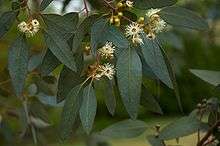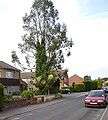Eucalyptus gunnii
Eucalyptus gunnii, commonly known as cider gum,[4] is a species of small to medium-sized tree endemic to Tasmania. It has mostly smooth bark, lance-shaped to egg-shaped adult leaves, flower buds in groups of three, white flowers and cylindrical to barrel-shaped fruit.
| Cider gum | |
|---|---|
 | |
| Foliage and flowers | |
| Scientific classification | |
| Kingdom: | Plantae |
| Clade: | Tracheophytes |
| Clade: | Angiosperms |
| Clade: | Eudicots |
| Clade: | Rosids |
| Order: | Myrtales |
| Family: | Myrtaceae |
| Genus: | Eucalyptus |
| Species: | E. gunnii |
| Binomial name | |
| Eucalyptus gunnii | |
| Subspecies | |
| |
| Distribution | |
Description
Eucalyptus gunnii is a tree that typically grows to a height of 35 m (115 ft)[5]:391 and forms a lignotuber. It has smooth, mottled, white or grey bark, sometimes with persistent rough bark on the lower trunk. Young plants and coppice regrowth have sessile leaves arranged in opposite pairs. The juvenile leaves are heart-shaped to more or less round, greyish green or glaucous, 13–45 mm (0.51–1.77 in) long and 17–40 mm (0.67–1.57 in) wide. Adult leaves are arranged alternately, lance-shaped to egg-shaped, the same dull greyish to bluish green on both sides, 40–90 mm (1.6–3.5 in) long and 12–35 mm (0.47–1.38 in) wide on a petiole 9–23 mm (0.35–0.91 in) long.
The flowers are arranged in leaf axils in groups of three on an unbranched peduncle 3–9 mm (0.12–0.35 in) long, the individual buds sessile or on a pedicels up to 4 mm (0.16 in) long. Mature buds are oval, 5–9 mm (0.20–0.35 in) long and 3–5 mm (0.12–0.20 in) wide with a conical, rounded or flattened operculum. Flowers occurs in most months and the flowers are white. The fruit is a woody cylindrical to barrel-shaped capsule 5–9 mm (0.20–0.35 in) long and 5–7 mm (0.20–0.28 in) wide with the valves near rim level or enclosed.[4][6]
Taxonomy and naming
Eucalyptus gunnii was first formally described in 1844 by the British botanist Joseph Dalton Hooker in the London Journal of Botany. The type material was collected "on the elevated tablelands of the interior of Tasmania, especially in the neighborhood of the lakes" by Ronald Campbell Gunn.[7][8] The specific epithet honours the collector of the type material.[4]
Joseph Maiden's 1889 book The Useful Native Plants of Australia’ recorded that common names in Tasmania are "cider gum" and in southeastern Australia occasionally as the "sugar gum" and that in the same part it is known as "white gum", "swamp gum" or "white swamp gum". In the Noarlunga and Rapid Bay districts of South Australia it is known as "bastard white gum", occasionally as "yellow gum." Near Bombala, New South Wales two varieties go by the names of "flooded or bastard gum" and "red gum", although the species only occurs in Tasmania.[9]
Distribution and habitat
Cider gum grows in woodland and occurs on the plains and slopes of the central plateaux and dolerite mountains at altitudes up to about 1,100 m (3,600 ft), with isolated occurrences south of Hobart.[6][10][11]
Use in horticulture
This plant has gained the Royal Horticultural Society's Award of Garden Merit.[12][13] This species is noted for exceptional cold tolerance for a eucalyptus (to −14 °C, exceptionally −20 °C for brief periods) and is now commonly planted as an ornamental tree across the British Isles and some parts of western Europe.[14] Fast-growing, it will produce a tree up to 37 m (121 ft) tall when mature,[15] with growth rates of up to 1.5 m (4 ft 11 in), rarely 2 m (6 ft 7 in), per year.
Pruning can be employed to maintain the tree as a small shrub if required and more shaded spots will restrict growth. It does grow in full sun on sandy/chalky soils, well supplied with water, but prefers a loamy soil; it does not tolerate very wet sites. It is one of the most rustic eucalyptus trees alongside Eucalyptus pauciflora and Eucalyptus parvula.
Uses
The fragrant leaves give off essential oils when they are creased or burned, which are used in different forms (floral composition, infusion, tincture, oil, etc) to treat many respiratory diseases, rheumatism, migraines, fatigue and as antiseptic.[16]
Gallery
 Juvenile foliage of the cultivar 'Silver Drop'
Juvenile foliage of the cultivar 'Silver Drop' Given its rapid growth, it is better to plant E. gunnii at a safe distance from homes
Given its rapid growth, it is better to plant E. gunnii at a safe distance from homes Young specimen in Maranoa Gardens
Young specimen in Maranoa Gardens
References
- "Eucalyptus gunnii". Australian Plant Census. Retrieved 23 July 2019.
- "Eucalyptus gunnii subsp. divaricata". Australian Plant Census. Retrieved 23 July 2019.
- "Eucalyptus gunnii subsp. gunnii". Australian Plant Census. Retrieved 23 July 2019.
- "Eucalyptus gunnii". Euclid: Centre for Australian National Biodiversity Research. Retrieved 2 June 2020.
- Stace, C. A. (2019). New Flora of the British Isles (Fourth ed.). Middlewood Green, Suffolk, U.K.: C & M Floristics. ISBN 978-1-5272-2630-2.
- "Eucalyptus gunnii". Flora of Australia. Australian Biological Resources Study, Department of the Environment and Energy, Canberra. Retrieved 24 July 2019.
- "Eucalyptus gunnii". APNI. Retrieved 23 July 2019.
- Hooker, Joseph Dalton; Hooker, William Jackson (ed.) (1844). "Note of the Cider Tree". London Journal of Botany. 3: 499–501. Retrieved 24 July 2019.CS1 maint: extra text: authors list (link)
- Maiden, Joseph (1889). The useful native plants of Australia (including Tasmania). Sydney: Turner and Henderson. p. 27. Retrieved 24 July 2019.
- Kirkpatrick, J. B. & Backhouse, Sue. (2004), Native trees of Tasmania illustrations Sue Backhouse Pandani Press, Sandy Bay, Tas. (Seventh Edition) ISBN 0-646-43088-2. pp. 98
- Brooker, K. (1996). Eucalyptus. An illustrated guide to identification. Reed Books, Melbourne
- "Eucalyptus gunnii AGM". Royal Horticultural Society. Retrieved 19 June 2020.
- "AGM Plants - Ornamental" (PDF). Royal Horticultural Society. July 2017. p. 37. Retrieved 18 February 2018.
- Brooker, M. (1983). A Key to Eucalypts in Britain and Ireland. Forestry Commission Booklet 50.
- Tree Register of the British Isles
- Trees: field guide ; Johnson, Owen and More, David; translator: Pijoan Rotger, Manuel, ed. Omega, 2006. ISBN 978-84-282-1400-1
| Wikimedia Commons has media related to Eucalyptus gunnii. |